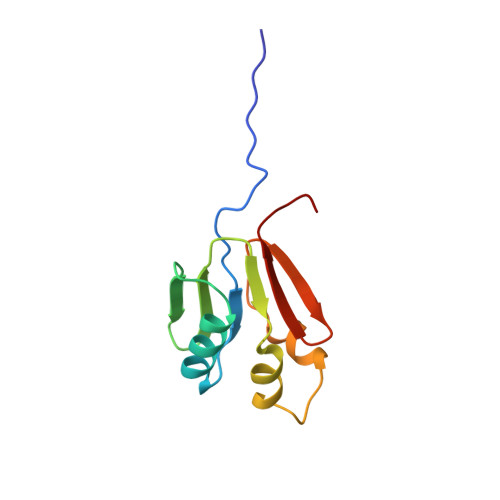Solution structure of the toluene 4-monooxygenase effector protein (T4moD).
Hemmi, H., Studts, J.M., Chae, Y.K., Song, J., Markley, J.L., Fox, B.G.(2001) Biochemistry 40: 3512-3524
- PubMed: 11297417
- DOI: https://doi.org/10.1021/bi0013703
- Primary Citation of Related Structures:
1G10, 1G11 - PubMed Abstract:
Toluene 4-monooxygenase (T4MO) from Pseudomonas mendocina catalyzes the NADH- and O(2)-dependent hydroxylation of toluene to form p-cresol. The complex consists of an NADH oxidoreductase (T4moF), a Rieske ferredoxin (T4moC), a diiron hydroxylase [T4moH, with (alphabetagamma)(2) quaternary structure], and a catalytic effector protein (T4moD). The solution structure of the 102-amino acid T4moD effector protein has been determined from 2D and 3D (1)H, (13)C, and (15)N NMR spectroscopic data. The structural model was refined through simulated annealing by molecular dynamics in torsion angle space (DYANA software) with input from 1467 experimental constraints, comprising 1259 distance constraints obtained from NOEs, 128 dihedral angle constraints from J-couplings, and 80 hydrogen bond constraints. Of 60 conformers that met the acceptance criteria, the 20 that best satisfied the input constraints were selected to represent the solution structure. With exclusion of the ill-defined N- and C-terminal segments (Ser1-Asn11 and Asp99-Met102), the atomic root-mean-square deviation for the 20 conformers with respect to the mean coordinates was 0.71 A for the backbone and 1.24 A for all non-hydrogen atoms. The secondary structure of T4moD consists of three alpha-helices and seven beta-strands arranged in an N-terminal betaalphabetabeta and a C-terminal betaalphaalphabetabetabeta domain topology. Although the published NMR structures of the methane monooxygenase effector proteins from Methylosinus trichosporium OB3b and Methylococcus capsulatus (Bath) have a similar secondary structure topology, their three-dimensional structures differ from that of T4moD. The major differences in the structures of the three effector proteins are in the relative orientations of the two beta-sheets and the interactions between the alpha-helices in the two domains. The structure of T4moD is closer to that of the methane monooxygenase effector protein from M. capsulatus (Bath) than that from M. trichosporium OB3b. The specificity of T4moD as an effector protein was investigated by replacing it in reconstituted T4MO complexes with effector proteins from monooxygenases from other bacterial species: Pseudomonas pickettii PKO1 (TbuV, toluene 3-monooxygenase); Pseudomonas species JS150 (TbmC, toluene 2-monooxygenase); and Burkeholderia cepacia G4 (S1, toluene 2-monooxygenase). The results showed that the closely related TbuV effector protein (55% sequence identity) provided partial activation of the complex, whereas the more distantly related TbmC (34% sequence identity) and S1 (29% sequence identity) did not. The (1)H NMR chemical shifts of the side-chain amide protons of Asn34, a conserved, structurally relevant amino acid, were found to be similar in spectra of effector proteins T4moD and TbuV but not in the spectrum of TbmC. This suggests that the region around Asn34 may be involved in structural aspects contributing to functional specificity.
Organizational Affiliation:
National Magnetic Resonance Facility at Madison and Department of Biochemistry, College of Agricultural and Life Sciences, University of Wisconsin, Madison Wisconsin 53706-1544, USA.














